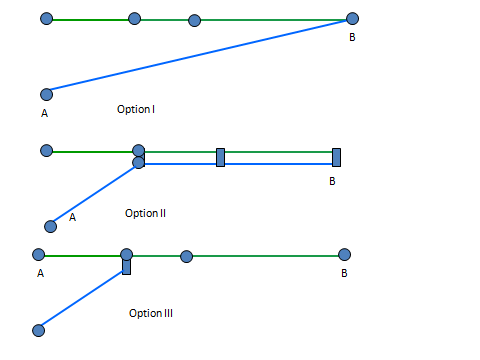6.9Pulling Services onto a BRT Trunk Corridor from a Parallel Corridor
Eventually, all things merge into one, and a river runs through it.Norman Maclean, author, 1902–1990
If the BRT trunk corridor is not saturated after adding all the existing routes onto the corridor by the BRT service plan, it may be advantageous to take a bus route that currently does not use the BRT corridor, and pull it onto the BRT corridor. The result will likely be a travel time savings for some customers, as their trip will be sped up on the BRT portion of the route. However, it could also mean a travel time loss for other customers, if the rerouting results in a longer trip for them or longer walks. These costs and benefits need to be weighed in order to make the decision.

Above are three simplified scenarios that show the basic options for handling an existing route that travels near the BRT corridor.
- Option I represents the way bus routes are currently configured—the green line is the BRT corridor with a BRT route on top of it, and the blue line is an existing bus route that travels near the BRT corridor and ends in the same place;
- Option II represents a decision to “route on” the blue service to use the BRT infrastructure, but retain it as a “direct service”;
- Option III represents a route that has been “routed on” to a BRT corridor, but split into a trunk feeder service.
If there is sufficient demand to justify it, a fourth option would be to retain the current route and add a new route that uses the BRT trunk corridor for part of the route. Option I is preferable when pulling a bus service onto a new, faster BRT corridor introduces more delay due to the indirectness of the route than it saves due to the superior BRT infrastructure. Option II is preferred when the travel-time savings of pulling the route onto the BRT corridor for part of its journey saves more time and serves as many customers as the current route operating in mixed traffic conditions. Option II introduces some indirectness of route but avoids any transfer penalty. Option III would be preferred mainly when there are significant time savings benefits to rerouting onto the BRT trunk corridor, yet the addition of a fully direct service in the optimal vehicle size for that service would saturate the BRT corridor, slowing down the speeds for the busway. The indirectness of route and transfer penalty would need to be compensated by both the higher speeds of using the BRT trunk corridor and the higher frequencies in the new feeder route.
In some cases, it is best to create a hybrid of Options I and II, where the blue route is routed onto the BRT corridor, while the original blue route service is retained. Frequency would need to be split between the two, and this would allow customers who benefit more from one or the other scenario to have the option of which route to take. Many of the issues described in the limited-services section apply here since you are again splitting frequencies. However, this might also be a more politically feasible solution—even when there are greater benefits to routing a service onto the BRT corridor—because it can often be politically challenging to eliminate a route altogether.
Contributors: Walter Hook , BRT Planning International; Pedro Szász , consultant; Arthur Szász , Protocubo; Annie Weinstock , BRT Planning International; Ulises Navarro , ITDP Latin America; Chris Kost , ITDP Africa; Karl Fjellstrom, Far East BRT